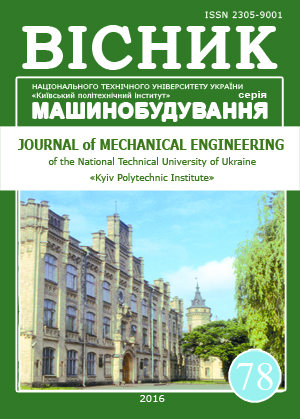EXERGIC ANALYSIS AND VARIATIONAL INEQUALITIES METHODS IN SOME FLUID MECHANIC’S PROBLEMS
DOI:
https://doi.org/10.20535/2305-9001.2016.78.73382Keywords:
energy, exergy, variation inequalities, limiting equilibrium, shoreline erosionAbstract
Purpose. The foundations of the energetic approach for analyzing of the bodies with dissipation properties are presented in the article. Methodology. Energy resource of arbitrary body is characterized by the sum of the exergy and anergy. The first of them indicates the part of energy which can be used to perform mechanical work. The second – is a measure of the processes’ irreversibility in the interaction of such body with the others. It indicates what part of the energy dissipates into the environment as low-temperature heat and can’t be used for the mechanical work performance. The energy balance in the thermodynamic systems is the basis for the relevant variation principles formulation. The introduction of the exergy and anergy concept leads to the variation inequalities formulation. They are transformed into equality in almost non-realized case of the reverse ability and equilibrium process, or in the case of the limit equilibrium state. Conclusion. Variation inequalities can be used for the formulation of general relations, which determine the parameters of quasi-static flow of real fluid in its interaction with solid obstacles - wetted perimeter of pipe or open channel, as well as the inclusions - in the cases of unknown interaction surface. These problems in particular arise in the analysis of the erosion process and shoreline destruction it caused, river flow interaction with stones during floods in natural streams.References
LaGrange, J. (1950), Analiticheskaja mehanika [Analytical mechanics], Gosizdat, Moscow, Russia.
Polac, L.S. (ed.) (1959), Variacionnyje principy mehaniki [Variational principles of mechanics], Gosizdat, Moscow, Russia.
Rectoris, K. (1985), Variacionnyje metody v matematicheskoj fizike i tehnike [Variational methods in mathematical physics and engineering], Mir, Moscow, Russia.
Saltanov, N.V. (1984), Analiticheskaja gidromehanika [Analytical fluid mechanics], Nauk. dumka, Kijiv, Ukraine.
Lancosh, K. (1985), Variacionnyje principy mehaniki [Variational principles of mechanics], Mir, Moscow, Russia.
Sedov, L.I. (1981), Izbrannyje voprosy sovremennoj mehaniki [Selected topics of the modern mechanics], Izdatelstvo Moskovskogo universiteta, Moscow, vol. 1 pp. 11 – 64.
Berdichevskij, V.L. (1983), Variacionnyje principy mehaniki sploshnoj sredy [Variational principles of continuum mechanics], Nauka, Moscow, Russia.
Abovskij, N.P., Andreejv, N.P., and Deruga A.P. (1978), Variacionnyje principy teorii uprugosti i teorii obolochek [Variational principles of the theory elasticity and the shells theory], Nauka, Moscow, Russia.
Mihlin, S.G. (1970), Variacionnyje principy v matematicheskoj fizike [Variational principles in mathematical physics], Nauka, Moscow, Russia.
Washizu, K. (1987), Variacionnyje metody v teorii uprugosti i plastichnosti [Variational methods in elasticity and plasticity], Mir, Moscow, Russia.
Sedov, L.I. (1981), “Applied mathematics and mechanics”, vol. 45, no 6, pp. 963 – 984.
Duvo, G. and Lions, J. (1980L), Neravenstva v mehanike i fizike [Inequalities in mechanics and physics], Mir, Moscow, Russia.
Kinderlehrer, D. and Stampacchia, G. (1983), Vvedenie v variacionnye neravenstva i ih prilojenia [An introduction to variational inequalities and their applications], Mir, Moscow, Russia.
Brodianskogo, V.M. (ed.) (1968), Energia i eksergia [Energy and exergy], Mir, Moscow, Russia.
Byer, G. (1968), Energia i eksergia [Energy and exergy], in. Brodianskogo, V.M. (ed.), Mir, Moscow, Russia.
Panasiuk, V.V. (1968), Predel’noje ravnovesije hrupkih tel s treshchinami [Limit equilibrium of brittle bodies with cracks], Nauk. Dumka, Kyiv, Ukraine.
Pelekh, B.L. (1982), Reports of the USSR Academy of Sciences. Series A. Physics, mathematics and engineering sciences, no 6, pp. 46 – 49.
Yahno, O.M., Matijega, V.M. and Odajskij, S.I. (2010), Tehnichna gidrodynamika i osnovy teorii zmashchuvannia [Technical fluid dynamics and basics of lubrication theory], “Zoloti lytavry”, Chernivci, Ukraine.
Kragel’skogo, I.V. and Alisina, V.V. (ed.) (1978), Trenije, iznashyvanie i smazka [Friction, wear and lubrication], Spravochnik, in. vol. 2, vol. 1, Mashinostoenie, Moscow, Russia.

